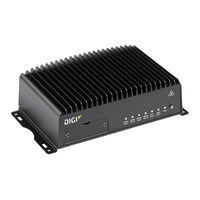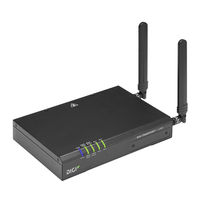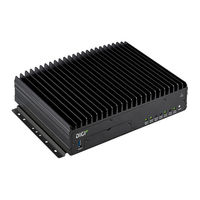Digi TX64 Manuals
Manuals and User Guides for Digi TX64. We have 4 Digi TX64 manuals available for free PDF download: User Manual
Digi TX64 User Manual (1087 pages)
Brand: Digi
|
Category: Network Router
|
Size: 19 MB
Table of Contents
-
TX54 Leds28
-
Power28
-
GNSS Service29
-
WWAN Signal29
-
WWAN Service29
-
Local Webui39
-
Interfaces57
-
Configure a LAN141
-
Delete a LAN161
-
DHCP Servers163
-
Bridging183
-
Serial Port196
-
Wi-Fi232
-
Hotspot286
-
Hotspot Security288
-
Routing340
-
IP Routing341
-
Routing Services364
-
Dynamic DNS369
-
Vrrp375
-
Configure VRRP375
-
Configure VRRP379
-
Ipsec401
-
Ipsec Mode401
-
Ipsec Modes401
-
Authentication402
-
Openvpn455
-
Show GRE Tunnels492
-
L2Tp508
-
L2TP with Ipsec526
-
L2Tpv3 Ethernet528
-
Nemo534
-
Show NEMO Status540
-
Configure DNS571
-
Show DNS Server577
-
SNMP Security578
-
Download Mibs583
-
Modbus Gateway619
-
System Time636
Advertisement
Digi TX64 User Manual (1113 pages)
Brand: Digi
|
Category: Network Router
|
Size: 17 MB
Table of Contents
-
Local Webui35
-
Learn more68
-
Interfaces69
-
Delete a LAN171
-
DHCP Servers173
-
Bridging201
-
Serial Port213
-
Wi-Fi259
-
Hotspot313
-
Hotspot Security315
-
Routing368
-
IP Routing369
-
Routing Services397
-
Dynamic DNS403
-
Vrrp410
-
Configure VRRP410
-
Configure VRRP414
-
Ipsec436
-
Ipsec Mode436
-
Ipsec Modes436
-
Authentication437
-
Openvpn493
-
Show GRE Tunnels532
-
L2Tp549
-
L2TP with Ipsec567
-
L2Tpv3 Ethernet569
-
Nemo575
-
Show NEMO Status581
-
Configure DNS614
-
Show DNS Server620
-
SNMP Security622
-
Download Mibs627
-
Modbus Gateway659
-
System Time677
-
Python Modules716
Digi TX64 User Manual (931 pages)
Brand: Digi
|
Category: Network Router
|
Size: 16 MB
Table of Contents
-
-
-
Interfaces
48-
-
Bridging165
-
-
Serial Port
174 -
Wi-Fi
192 -
Hotspot
243-
Hotspot Security245
-
-
Routing
297-
IP Routing298
-
Dynamic DNS327
-
-
-
Ipsec359
-
Ipsec Modes359
-
Authentication360
-
Openvpn407
-
Nemo460
-
-
Services
470-
Configure DNS497
-
Show DNS Server503
-
-
Modbus Gateway538
-
System Time555
Advertisement
Digi TX64 User Manual (831 pages)
Brand: Digi
|
Category: Network Router
|
Size: 14 MB
Table of Contents
-
-
TX64 Leds20
-
-
Interfaces
40-
-
Bridging141
-
-
Serial Port
151 -
Wi-Fi
177 -
Hotspot
221-
Hotspot Security223
-
-
Routing
274-
IP Routing275
-
Dynamic DNS303
-
-
-
Ipsec315
-
Ipsec Modes315
-
Authentication316
-
Openvpn357
-
-
Services
412-
Configure DNS438
-
System Time473
Advertisement



